More photos from Gregor's workshop
A few more pictures of interesting details around Gregor's workshop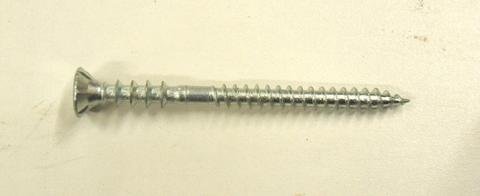 This is an interesting sort of specialty wood screw. It's meant for installations.
This is an interesting sort of specialty wood screw. It's meant for installations.
Imagine screwing something to a wall, but needing it to have a slight space from the
wall, and wanting to be able to adjust that. One would use one of these screws, screw
it all the way in, and then back it out a bit to adjust. The "threads" near the screw's
head, being just round instead of helical, are forced into the grain on screwing in,
but then pull the pieces apart when backing the screw out.
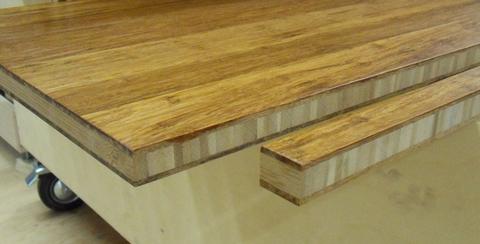 Gregor uses a lot of these sheets of bamboo. They are laminated together out of many
little rods of bamboo. Bamboo is a very hard and heavy sort of wood, and relatively cheap
as raw material. Assembling sheets like that is very labour intensive, so
a 4'x8' sheet of this material costs about $350. If it wasn't for the price, I'd start
using some of this too!
Gregor uses a lot of these sheets of bamboo. They are laminated together out of many
little rods of bamboo. Bamboo is a very hard and heavy sort of wood, and relatively cheap
as raw material. Assembling sheets like that is very labour intensive, so
a 4'x8' sheet of this material costs about $350. If it wasn't for the price, I'd start
using some of this too!
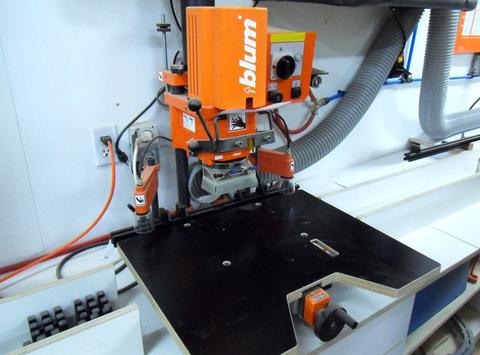 This is a hinge boring machine. It drills the main hole, plus the two mounting
holes for euro style hinges in one go.
This is a hinge boring machine. It drills the main hole, plus the two mounting
holes for euro style hinges in one go.
Somehow, I couldn't imagine a woodworking machine of that colour sold here.
It seems we (in Canada and the US) always think that old and from cast iron
is better. Even our new machines try to evoke a bit of that image.
We are too caught up in tradition - and don't even get me started about the
hand cut dovetail enthusiasts out there!
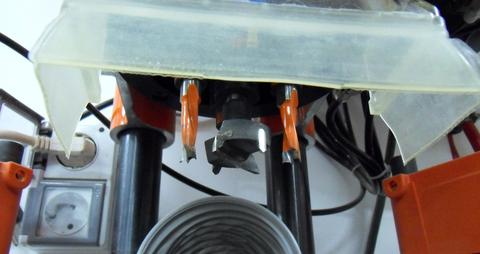 The drill bits of the hinge boring machine. It's interesting that all three of the drill bits
are counterclockwise bits. It's normal for half the bits of a line boring machine to
run counterclockwise, though maybe a bit odd that all three bits of this machine are
counterclockwise.
The drill bits of the hinge boring machine. It's interesting that all three of the drill bits
are counterclockwise bits. It's normal for half the bits of a line boring machine to
run counterclockwise, though maybe a bit odd that all three bits of this machine are
counterclockwise.
The machine is from Germany, and rather than change the power cord to a North American
220V plug, Gregor added some European style 220V sockets to his shop.
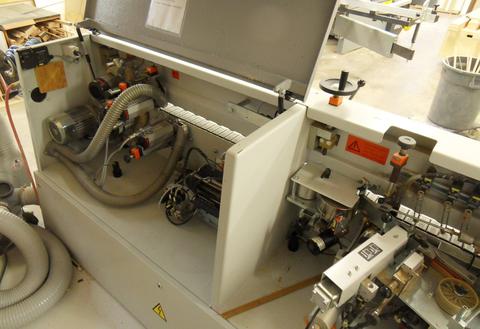 I never gave much thought to what an edgebander does. I always just thought it was a
machine that glues edging onto panels. But looking in the back of Gregor's edgebander,
there's quite a bit inside. The part on the right is for gluing.
I never gave much thought to what an edgebander does. I always just thought it was a
machine that glues edging onto panels. But looking in the back of Gregor's edgebander,
there's quite a bit inside. The part on the right is for gluing.
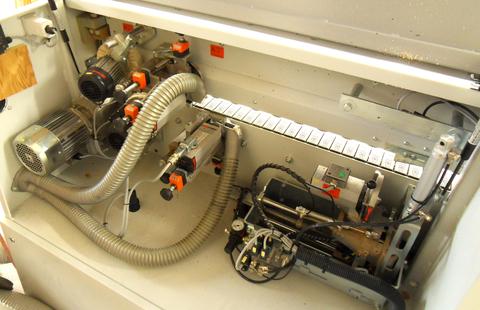 The part on the left, inside of an enclosure, is for cutting.
From right to left is a little saw that flush cuts the ends of the edge banding.
That saw flush cuts the edgebanding on either end. It moves side-to-side
as it cuts to follow the moving stock.
Next, two cutters for flush trimming and rounding the edges, then two buffing wheels,
and finally, the drive motor for the transport.
The part on the left, inside of an enclosure, is for cutting.
From right to left is a little saw that flush cuts the ends of the edge banding.
That saw flush cuts the edgebanding on either end. It moves side-to-side
as it cuts to follow the moving stock.
Next, two cutters for flush trimming and rounding the edges, then two buffing wheels,
and finally, the drive motor for the transport.
You can enlarge this, or any other image in this article by clicking on it.
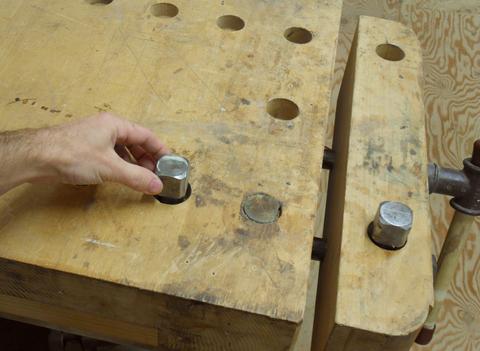 For all the workbench enthusiasts out there, check out these bench dogs on Gregor's workbench.
Hard to get a sense of scale, but look at my hand for size reference. You can also click
on the image to enlarge it.
For all the workbench enthusiasts out there, check out these bench dogs on Gregor's workbench.
Hard to get a sense of scale, but look at my hand for size reference. You can also click
on the image to enlarge it.
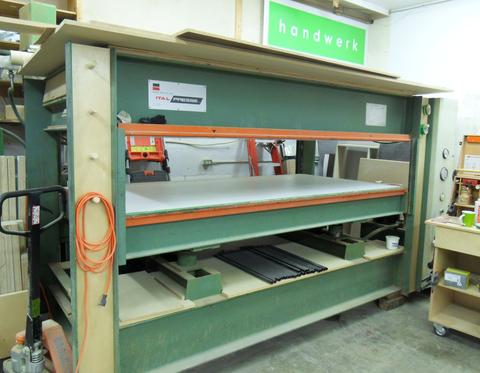 Gregor's veneer press. Greogr figures this is one of two or three veneer presses in all
of Ottawa. In Germany, it's quite normal for a cabinetmaker to have a veneer press of this
sort. This press allows him to make custom laminations not locally available.
Gregor's veneer press. Greogr figures this is one of two or three veneer presses in all
of Ottawa. In Germany, it's quite normal for a cabinetmaker to have a veneer press of this
sort. This press allows him to make custom laminations not locally available.
Right when I entered his workshop, I saw some birch plywood with a plastic coating on either side. That sort of thing is readily available in Germany, and is a favourite for making jigs, such as Uli's projects. I wish I knew where to buy it here. I asked "where did you get that?", Gregor's answer was "I laminated that in my veneer press".
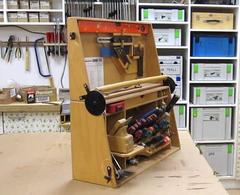 I also saw this really cleever tool chest with a very clever hinge design.
I thought that was so neat I wrote a separate little article and video
about the
hinge design on this tool chest
I also saw this really cleever tool chest with a very clever hinge design.
I thought that was so neat I wrote a separate little article and video
about the
hinge design on this tool chest
Back to Main article